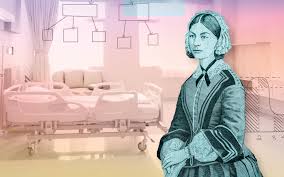
Why Every Nursing Student Should Know Nightingale’s Theory
As we dive into nursing theories, Florence Nightingale’s Environmental Theory isn’t just history – it’s the foundation of modern nursing practice. Developed during the Crimean War (1850s), this theory remains shockingly relevant today. Here’s why it matters to us as students:
The Core Concept: Environment as Medicine
Nightingale believed that the environment could either heal or harm patients. She identified five essential components:
- Pure fresh air – “The very first canon of nursing”
- Pure water – Both for drinking and cleanliness
- Effective drainage – Preventing stagnation and contamination
- Cleanliness – Of both patient and environment
- Light – Especially direct sunlight
Clinical Connection: Think about how we:
- Open curtains for natural light during morning care
- Ensure proper ventilation in patient rooms
- Meticulously practice infection control
Key Principles for Nursing Practice
1. Observation Skills
Nightingale emphasized that nurses must be keen observers – not just of symptoms, but of the entire patient environment.
Student application: During clinicals, practice noticing:
- Room temperature (too cold/too hot?)
- Noise levels affecting rest
- Accessibility of call bell/water
2. The Healing Power of Nature
She advocated for what we now call “nature-based interventions”:
- Positioning beds for sunlight exposure
- Incorporating plants/greenery in healthcare spaces
- Fresh air circulation
Modern evidence: Studies show patients with window views recover faster (Ulrich, 1984) – proving Nightingale right!
3. Nutrition Matters
Long before “nutritional nursing” became a specialty, Nightingale stressed:
- Regular meal timing
- Appealing food presentation
- Monitoring what patients actually consume
Clinical tip: When doing intake/output, don’t just record numbers – observe eating patterns.
Nightingale in Modern Healthcare
Infection Control Pioneer
Her handwashing and sanitation practices reduced Crimean War hospital deaths by 2/3. Sound familiar? This is the foundation of:
- Current PPE protocols
- Hospital-acquired infection prevention
- Isolation procedures
Nursing Documentation
She created the first standardized hospital statistics forms – the ancestor of our:
- Electronic health records
- Care plans
- Progress notes
Applying Nightingale’s Theory Today
Case Example: Post-op patient with poor wound healing
| Nightingale Principle | Nursing Action |
|---|---|
| Cleanliness | Meticulous wound care protocol |
| Light | Ensure proper lighting for dressing changes |
| Quiet | Cluster care to promote rest |
| Nutrition | Collaborate with dietitian on protein needs |
Critical Perspective: Limitations to Consider
While revolutionary, the theory has gaps we should recognize:
- Less focus on psychological aspects (developed before mental health nursing)
- Minimal patient autonomy emphasis (reflects 19th century norms)
- Doesn’t address high-tech environments like ICUs
NCLEX Alert!
Expect questions testing your understanding of:
- Basic patient safety/environment needs
- Infection control priorities
- Foundational nursing history
Sample question:
Correct answer: “Ensuring the room is clean, well-ventilated, and has functioning call light.”
“A nurse is preparing a room for a new admission. Which action best reflects Nightingale’s principles?”
Why This Still Matters in Nursing School
- Fundamentals connection: Her principles appear in every basic skills lab
- Public health relevance: COVID-19 proved environment’s role in health
- Holistic care roots: The beginning of seeing patients in context
Discussion Challenge
Next clinical posting, try this:
- Choose one patient
- Assess their environment using Nightingale’s 5 components
- Identify one environmental improvement you could make
- Reflect on how it might affect recovery
Final Thought: Nightingale teaches us that sometimes the most powerful interventions aren’t high-tech – they’re about optimizing the basics. As students, mastering these fundamentals makes all the difference in patient outcomes.
Want to dive deeper? Check out Nightingale’s original “Notes on Nursing” – surprisingly readable for 19th century text! What environmental factors have you noticed affecting patients in your clinicals?
